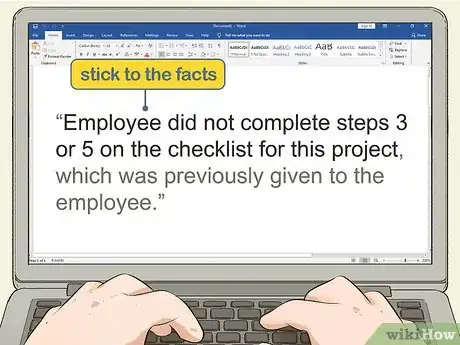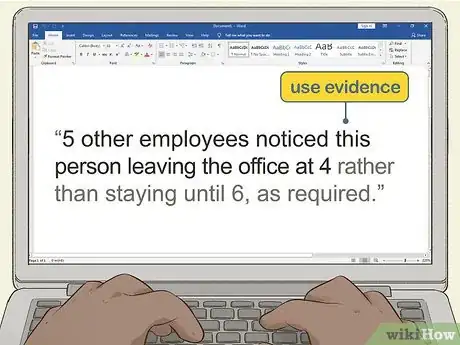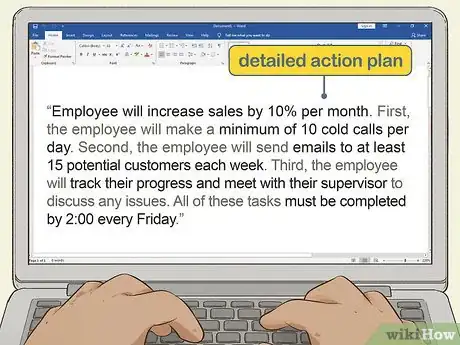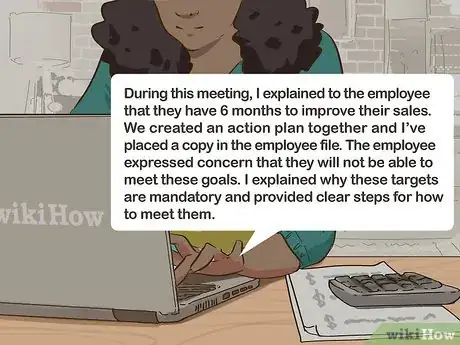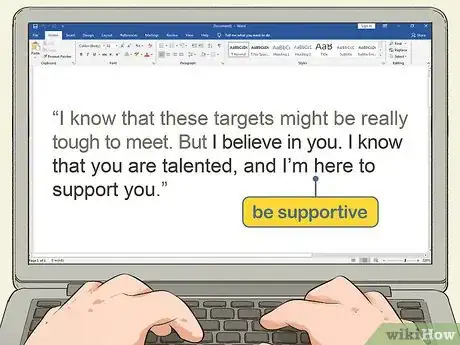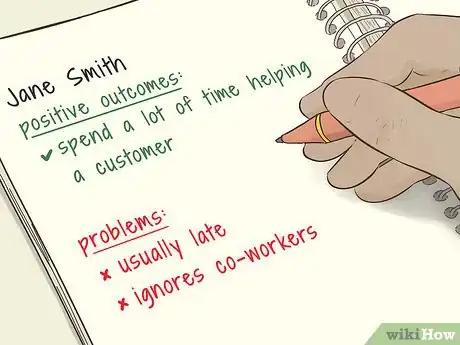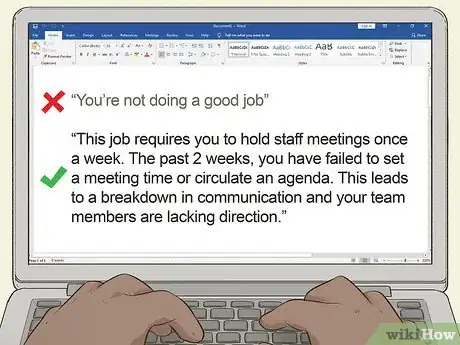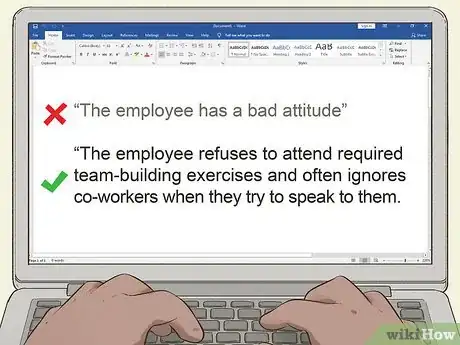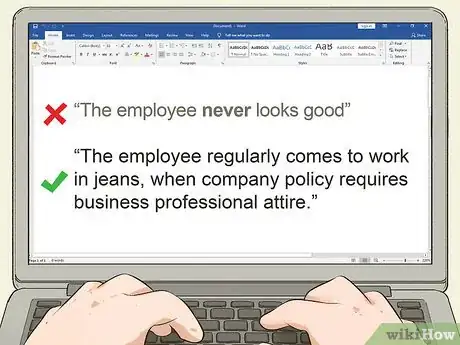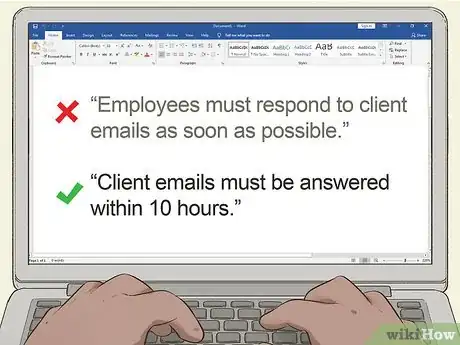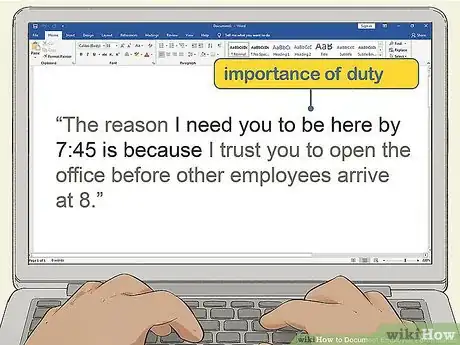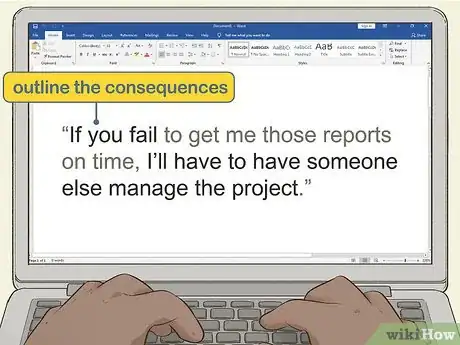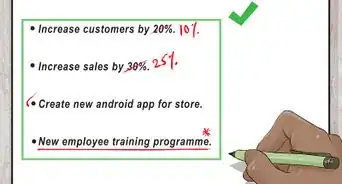This article was co-authored by Joe Simmons. Joe Simmons is a Corporate Trainer based in West Palm Beach, Florida. Joe specializes in operations management, leadership, learning and development, and employee training to help employees become high-performing teams. He holds a Bachelor’s degree in Marketing from The University of South Florida. Joe’s coaching has helped numerous organizations with employee retention, revenue growth, and team productivity.
This article has been viewed 61,116 times.
Documenting employee performance is important for getting the most out of your team members and making sure employees are treated fairly. Provide precise, detailed, accurate feedback, which will benefit both you and your employees. Use language that is constructive and easy to understand. Also, ensure that employees understand company policies so they know what's expected of them.
Steps
Using Detailed and Precise Documentation
-
1Identify which rule or policy was violated, if applicable. Provide all employees with a handbook or other set of company guidelines. Even if you own a small business with only a few employees, you can still create a brief set of rules. That way, when you provide feedback you can reference these policies. For both written and verbal feedback, you need to clearly state the issue and support your statement with facts that you know to be true.[1]
- For example, you might say, “Employee did not complete steps 3 or 5 on the checklist for this project, which was previously given to the employee.”
- Point out which rule was broken. You might write, "The employee handbook clearly states that employees need to use the company car to make deliveries. This employee used their personal vehicle without permission."
-
2Use evidence to support the facts. You can protect yourself and the company from employee complaints by making sure to support your documentation with evidence. For example, if an employee didn’t complete an important report, you can use the incomplete report as evidence.[2]
- You can also ask other employees to serve as witnesses. For example, you might write, “5 other employees noticed this person leaving the office at 4 rather than staying until 6, as required.”
- If you are documenting a poor client interaction, you might use emails or phone recordings as your evidence.
Advertisement -
3Explain the behavior that needs to change or continue. Put your recommendations in writing. For example, you might note, “Employee needs to follow the written guidelines for handling a customer complaint. Specifically, the employee needs to offer a clear solution to the customer.”[3]
- Discuss the report with the employee. You can say, “Here you can see that I wrote down how I would like you to improve. In the future, please offer the customer a solution instead of saying that the problem is not your fault. Is that clear?”
-
4Draw up a specific action plan. An action plan lays out the steps that need to be taken in order to improve. To make your employee feel like a valued part of the team, ask them to help you draft the plan. Start by setting goals, then write down how the employee will accomplish those goals. Make sure to include a deadline for each step.[4]
- You could write, “Employee will increase sales by 10% per month. First, the employee will make a minimum of 10 cold calls per day. Second, the employee will send emails to at least 15 potential customers each week. Third, the employee will track their progress and meet with their supervisor to discuss any issues. All of these tasks must be completed by 2:00 every Friday.”
-
5Keep a detailed record of all conversations. Keeping a record is important because if the employee later issues a complaint, you’ll have extra documentation to show how you handled the situation. After you finish a conversation about performance, take a few minutes to record the important points. You can also jot down notes during the meeting so that you don’t miss any big details.[5]
- Create a file for each employee. It can be an electronic or paper file (or both). Any time you make notes about an employee, place them in the file.
- Write something like, “During this meeting, I explained to the employee that they have 6 months to improve their sales. We created an action plan together and I’ve placed a copy in the employee file. The employee expressed concern that they will not be able to meet these goals. I explained why these targets are mandatory and provided clear steps for how to meet them.”
-
6Show that you are supportive. Remember, this meeting should be productive for both you and the employee. Of course, you should point out issues, but make sure to also offer some encouragement. The employee is likely to perform better if they feel supported.[6]
- Try saying, “I know that these targets might be really tough to meet. But I believe in you. I know that you are talented, and I’m here to support you.”
Giving Effective Feedback
-
1Provide feedback to all employees you supervise directly. Typically, the employee's manager should be the one to provide feedback. If you manage people, it is your job to give them timely, clear feedback. In some cases, it might be more appropriate for someone from Human Resources to address the issue. For example, if it is a sensitive issue regarding health, an HR professional might be better equipped to handle the issue.
- If you are a small business owner, you might want to be in charge of providing feedback to all of your employees. Alternatively, you can delegate it to an employee that you trust.
- All employees should receive feedback, whether they are part-time or full-time. At the very least, set up a quarterly meeting to check-in. But also give feedback anytime you see an issue with performance.
- Metrics are a great way to track your employee's progress.[7]
-
2Document both problems and positive outcomes. It's important to track overall performance so that you can objectively evaluate how the employee is doing. That means that you need to document it whenever an issue occurs. For example, if you are a small business owner, you might have a problem with employees showing up on time. Each time someone is late, make a note in their file. You should also mention it to them in person.[8]
- Also make a point to document it when someone does something well. For example, if your employee made it a point to spend a lot of time helping a customer, make a note in their file that they went above and beyond. Also, tell them in person that you appreciate their efforts.
- You can also send feedback in an email to have further documentation.
-
3Give feedback in a timely manner. Providing feedback quickly allows you to correct any issues that have arisen and it also ensures that the performance issue is fresh in the employee’s mind. If you need to give someone feedback, try to do so as soon as possible. This might mean at the end of the day, or even at the moment. If it’s a more complicated issue, take a few days to make your plan.
- If an employee is arguing with a co-worker or client, it’s okay to draw them aside to address the situation immediately. You can always follow up later with written feedback.
- Make sure to give positive feedback, too. You might say to an employee, “I noticed you’ve been taking on a lot more responsibility lately. Let’s meet next week to talk about leadership opportunities that are available.”
- Follow up with an email to remind them of what you spoke about.
-
4Use specific language to make your points clear. Avoid using generalities. You don’t want any ambiguity in your feedback. Use precise language to clearly state the issue and how it needs to be handled.[9]
- Don’t say, “You’re not doing a good job.” Instead, be specific and say, “This job requires you to hold staff meetings once a week. The past 2 weeks, you have failed to set a meeting time or circulate an agenda. This leads to a breakdown in communication and your team members are lacking direction.”
- Avoid contradicting previous feedback. For example, maybe you own a small boutique. If you asked an employee to make a display of fall boots, don't later say that they should have highlighted sweaters instead.
-
5Choose objective terms to describe performance. Objective words rely on facts, whereas subjective terms can often involve feeling and emotions. Make sure to be objective when you give feedback so that you can use documentation and facts to support your points.
- Instead of saying, “The employee has a bad attitude,” say, “The employee refuses to attend required team-building exercises and often ignores co-workers when they try to speak to them.”
- Try saying, “The employee doesn’t look good,” say, “The employee regularly comes to work in jeans, when company policy requires business professional attire.”
-
6Avoid using absolutes. Absolutes are rarely true, so it’s best not to use them. Try not to say things like, “The employee is never on time,” or “The employee is always argumentative.” You likely won’t be able to prove these statements if the employee questions the feedback.[10]
Conveying Clear Goals and Standards
-
1Describe company policies in detail. Make sure that the employee has a written record of rules, regulations, and standards. You should also write a detailed job description so that they know what is required of them. Make a point to go over this written record in a conversation, too. That way, you can answer any questions that come up.[11]
- Don’t just say, “Employees must respond to client emails as soon as possible.” Instead, set clear expectations by saying, “Client emails must be answered within 10 hours.”
-
2Explain why each duty is important. Tell your employee the rationale behind these expectations. If they understand why they are necessary, they’re more likely to take them seriously. You can go over this each time you need to give the employee a reminder about how to do their job.
- You could say, “The reason I need you to be here by 7:45 is because I trust you to open the office before other employees arrive at 8.”
-
3Give the employee the resources they need to succeed. It’s your job to help your employees succeed, so make sure to give them the proper tools. When you explain your expectations, make sure that you have considered whether they have:
- Enough knowledge
- Enough team members
- The right equipment
- Enough time
-
4Outline the consequences of not meeting standards. Make sure that your employee understands what will happen if they don’t meet your expectations. Again, give them this information in writing and also follow-up with a conversation. Don’t try to threaten or scare your employee. Instead, calmly tell them what will happen if they don’t succeed.[12]
- You might say, “If you fail to get me those reports on time, I’ll have to have someone else manage the project.”
Expert Q&A
-
QuestionHow would you track the performance of your employees?
 Joe SimmonsJoe Simmons is a Corporate Trainer based in West Palm Beach, Florida. Joe specializes in operations management, leadership, learning and development, and employee training to help employees become high-performing teams. He holds a Bachelor’s degree in Marketing from The University of South Florida. Joe’s coaching has helped numerous organizations with employee retention, revenue growth, and team productivity.
Joe SimmonsJoe Simmons is a Corporate Trainer based in West Palm Beach, Florida. Joe specializes in operations management, leadership, learning and development, and employee training to help employees become high-performing teams. He holds a Bachelor’s degree in Marketing from The University of South Florida. Joe’s coaching has helped numerous organizations with employee retention, revenue growth, and team productivity.
Corporate Trainer Track employee performance with metrics at the beginning, middle, and end of the process. This way, you know how much progress your employee is making.
Track employee performance with metrics at the beginning, middle, and end of the process. This way, you know how much progress your employee is making. -
QuestionWhat are examples of metrics?
 Joe SimmonsJoe Simmons is a Corporate Trainer based in West Palm Beach, Florida. Joe specializes in operations management, leadership, learning and development, and employee training to help employees become high-performing teams. He holds a Bachelor’s degree in Marketing from The University of South Florida. Joe’s coaching has helped numerous organizations with employee retention, revenue growth, and team productivity.
Joe SimmonsJoe Simmons is a Corporate Trainer based in West Palm Beach, Florida. Joe specializes in operations management, leadership, learning and development, and employee training to help employees become high-performing teams. He holds a Bachelor’s degree in Marketing from The University of South Florida. Joe’s coaching has helped numerous organizations with employee retention, revenue growth, and team productivity.
Corporate Trainer One metric could measure how long it takes for an employee to finish a task, while another might measure how long it takes to solve a specific problem.
One metric could measure how long it takes for an employee to finish a task, while another might measure how long it takes to solve a specific problem.
References
- ↑ https://www.hracuity.com/blog/best-practices-documenting-employee-performance
- ↑ https://www.shrm.org/resourcesandtools/hr-topics/employee-relations/pages/performance-documentation.aspx
- ↑ https://www.shrm.org/resourcesandtools/hr-topics/employee-relations/pages/performance-documentation.aspx
- ↑ https://www.shrm.org/resourcesandtools/hr-topics/employee-relations/pages/performance-documentation.aspx
- ↑ https://www.hracuity.com/blog/best-practices-documenting-employee-performance
- ↑ https://www.hracuity.com/blog/best-practices-documenting-employee-performance
- ↑ Joe Simmons. Corporate Trainer. Expert Interview. 29 June 2021.
- ↑ https://www.entrepreneur.com/article/219437
- ↑ https://www.hracuity.com/blog/best-practices-documenting-employee-performance
